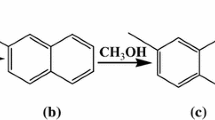Conclusions
-
1.
As the Na2O content of ultrahigh-silica zeolites increases, the yield of liquid catalysate and aromatic hydrocarbons from isobutylene at 500°C decreases.
-
2.
As the temperature of preliminary calcination increases from 500 to 1000°C, the water-sorption capacity of ultrahigh-silica zeolites gradually decreases. Calcination at 800–1000°C hardly affects the total zeolite activity but decreases its activity in the dehydrocyclization and hydrogen redistribution reactions. After zeolite calcination at 1000°C, an increase in selectivity for p-xylene formation is observed.
-
3.
The change in the catalytic properties of ultrahigh-silica zeolites after calcination at 800–1000°C is related to the removal of a small number of OH groups which enter into the composition of the active centers. The selectivity increase for p-xylene formation can be attributed to some changes in the pore structure at high temperature which make the diffusion of m- and o-xylene difficult.
Similar content being viewed by others
Literature cited
Kh. M. Minachev, D. A. Kondrat'ev, B. K. Nefedov, T. N. Bondarenko, A. A. Dergachev, and T. V. Alekseeva, Izv. Akad. Nauk SSSR, Ser. Khim., 2646 (1979).
Kh. M. Minachev, D. A. Kondrat'ev, B. K. Nefedov, A. A. Dergachev, T. N. Bondarenko, T. V. Alekseeva, and T. B. Borovinskaya, Izv. Akad. Nauk SSSR, Ser. Khim., 2509 (1980).
D. A. Kondrat'ev, T. N. Bondarenko, A. A. Dergachev, and E. N. Savost'yanov, Izv. Akad. Nauk SSSR, Ser. Khim., 1068 (1976).
Yu. S. Khodakov, V. S. Nakhshunov, and Kh. M. Minachev, Izv. Akad. Nauk SSSR, Ser. Khim., 1699 (1968).
J. C. Vedrine, A. Auroux, V. Bolis, P. Dejaifve, C. Naccache, P. Wierzchowski, E. G. Derouane, J. B. Nagy, J.-P. Gilson, J. H. C. van Hooff, J. P. van den Berg, and J. Wolthuisen, J. Catal.,59, 248 (1979).
P. Iru, L. Kubelkova, Ya. Novakova, Z. Tvaruzhkova, and V. Vikhterlova, The Problem of H-ZSM-5 Zeolite Activity, Summaries of the All-Union Conference on the Mechanism of Catalytic Reactions [in Russian], Vol. 1, Nauka, Moscow (1978), p. 25.
C. D. Chang and A. J. Silvestri, J. Catal.,47, 249 (1977).
J. R. Anderson, T. Mole, and V. Christov, J. Catal.,61, 477 (1980).
Author information
Authors and Affiliations
Additional information
Translated from Izvestiya Akademii Nauk SSSR, Seriya Khimicheskaya, No. 6, pp. 1310–1315, June, 1981.
Rights and permissions
About this article
Cite this article
Minachev, K.M., Kondrat'ev, D.A., Nefedov, B.K. et al. Effect of composition and calcination temperature on the catalytic properties of ultrahigh-silica zeolite in isobutylene conversions. Russ Chem Bull 30, 1042–1047 (1981). https://doi.org/10.1007/BF00950290
Received:
Issue Date:
DOI: https://doi.org/10.1007/BF00950290




